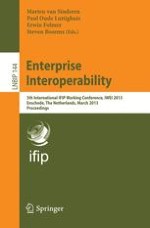This book constitutes the proceedings of the 5th International IFIP Working Conference on Enterprise Interoperability (IWEI 2013), held in Enschede, The Netherlands, during March 27–28, 2013. The theme for IWEI 2013 was “Information Services and Processes for the Interoperable Economy and Society.”
The 15 full papers presented in this volume were carefully selected from 35 submissions. The selection was based on a thorough review process, in which each paper was reviewed by at least three experts in the field. The papers are representative of the current research activities in the area of enterprise interoperability and are grouped into six sections: enterprise service interoperability, enterprise interoperability in sectors, interoperability methodology, interoperability for specific application types, strategic and tactical aspects of enterprise interoperability, and ontology-based interoperability. Two keynotes and an invited paper complete this volume.
